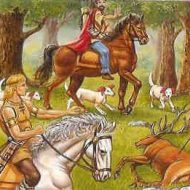Arawn : God of the Damned
Listen
At a glance
| Description | |
|---|---|
| Origin | Celtic Mythology |
| Classification | Gods |
| Family Members | Queen of Annwn (Wife) |
| Region | Wales |
| Associated With | Underworld, Death |
Arawn
Introduction
The Celtic god of war, terror, and retribution, Arawn, ruled the sacred realm of Annwn, and he has been mentioned in various branches of Welsh mythology. In later times, the role of the titular character was attributed to Gwyn ap Nudd, a Welsh psychopomp. But, in a traditional saying, the memory of Arawn is still held.
Arawn is often regarded as a pagan god, though he is not one of the main deities in Celtic mythology. In Welsh folklore, he is said to have been a king sent to oversee Annwn, one of the Otherworld’s many realms. He is believed to have been fair and impartial, and he would punish those who dared challenge his authority. Although Arawn’s past has been shrouded in mystery, his existence among the souls who believed in him was forever memorialized by Cardigan’s beliefs.
Physical Traits
He is skilled at manipulating his appearance and shapeshifting to resemble Pwyll is often described. He is a hunter who enjoys riding a black horse and working with his white hounds with red ears, which are also known as Hounds Of Annwn. His golden torc is a representation of his power and royalty, and he has grey and dark hair.
Family
Little is known of Arawn’s family beyond his unnamed wife, the Queen of Annwn, who loved her husband dearly.
Other names
Scholars believe that the name Arawn came from the name of Aaron, who was Moses’ brother. It’s believed that this was because of the Hebrew word “Aaron,” which literally means “highness.” Some people also linked him to Cernunnos, a Gaulish god who is related to hunting. One theory states that the Welsh god is the same as Arubianus due to their similar names.
Powers and Abilities
Responsible for his realm, Arawn is regarded as a fair and just ruler. He is known for his honor, duty, war, terror, hunting, and tradition. As the ruler of Annwn, he was also referred to as the Provider, the Virtuous, and the Guardian Of The Lost Souls. However, he is often regarded as evil due to his association with death. When Christianity spread across the British Isles, Arawn’s association with death became a cause for his demonization. Annwn became a place where souls were sought after, and he became the lord of the damned there. His hound companions were also associated with hellhounds.
Modern Day Influence
He is often referred to as the Arawn Death-Lord in Lloyd Alexander’s The Chronicles Of Prydain. Despite being regarded as an evil god, Arawn still struggles to control Annwn. He eventually loses his power due to the actions of the series’ heroes.
In D&D, he is regarded as the Celtic Lord Of The Underworld, a role that is closer to his portrayal in The Chronicles Of Prydain. Disney’s The Black Cauldron, which is based on the second book of the series, shows how he influenced the villains and Horned King. Even though Arawn never appears, he was initially regarded as the main antagonist. He was eventually replaced by the Horned King.
Related Images
Frequently Asked Questions
What is lorem Ipsum?
I am text block. Click edit button to change this text. Lorem ipsum dolor sit amet, consectetur adipiscing elit. Ut elit tellus, luctus nec ullamcorper mattis, pulvinar dapibus leo.
What is lorem Ipsum?
I am text block. Click edit button to change this text. Lorem ipsum dolor sit amet, consectetur adipiscing elit. Ut elit tellus, luctus nec ullamcorper mattis, pulvinar dapibus leo.
What is lorem Ipsum?
I am text block. Click edit button to change this text. Lorem ipsum dolor sit amet, consectetur adipiscing elit. Ut elit tellus, luctus nec ullamcorper mattis, pulvinar dapibus leo.
What is lorem Ipsum?
I am text block. Click edit button to change this text. Lorem ipsum dolor sit amet, consectetur adipiscing elit. Ut elit tellus, luctus nec ullamcorper mattis, pulvinar dapibus leo.
What is lorem Ipsum?
I am text block. Click edit button to change this text. Lorem ipsum dolor sit amet, consectetur adipiscing elit. Ut elit tellus, luctus nec ullamcorper mattis, pulvinar dapibus leo.









